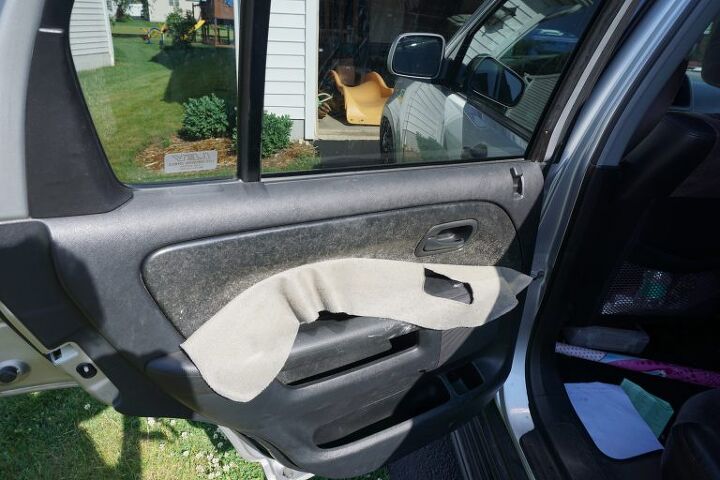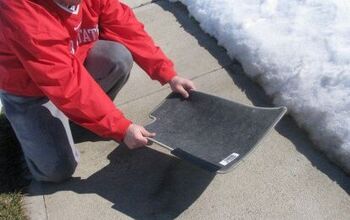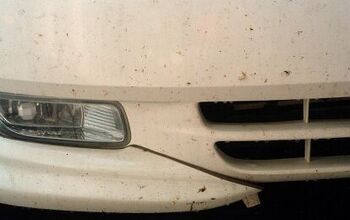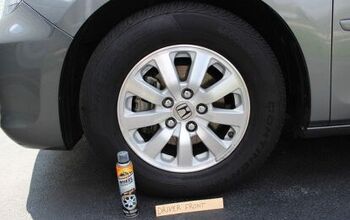Spare Me the Details - Saggy Fabric
After my last article about cleaning wheels two years ago, I was inundated with as many as one letter that requested I write about how to repair fabric that has come unglued.
Typically fabric repairs are not something that would be done during a car detail, but I like to give my fans what they want.
First off, if you’re restoring a classic Ferrari, stop reading now as this advice is well below your pay grade. If, however, you’re driving a Honda CR-V with 150,000 miles, two kids and a dog, and you’re tied of having sagging fabric, lend me your ears. This is not a professional repair, but rather a quick and effective solution to an annoying problem.
The best option to repair something like the example pictured is to remove the entire door panel. But I’d rather show you a quick fix that I trust most of you can do in 15 minutes. This will also work for small portions of sagging headliner, but probably not the entire ceiling.
I have tried quite a few products and far and away the best one for this type of repair is 3M Super 77 Multipurpose Adhesive. You can get a can at Walmart or an automotive store for about $8. Other adhesives will either leave a greasy residue behind that can often be seen through the fabric or damage other materials around it if you accidently overspray. Super 77 is surprisingly strong, yet very easy to clean up if you make a mistake.
You will need to clean the surface to be glued. I use a mild body solvent sprayed on a rag normally, but something like Goo Gone works just fine. You don’t need to have the surface perfectly clear of all the original glue, just make sure it is good and clean.
Next, mask off the area. You can use plain duct tape (don’t push it firmly down), but a better option would be painters tape.
Now it is time to apply the 3M Super 77. It is an aerosol spray adhesive and it doesn’t take much for it to work. Depending on the weather it can dry fast. After you spray, test it by touching it with your knuckle. If any of it comes off on your knuckle, it’s not ready. If it just feels tacky, then it is go time. If it’s hot out, this can be about 15 seconds so be ready.
Begin pressing the fabric back into place. I like to use a plastic razor here, but a credit card also works. Start in the middle and work your way out to eliminate any bubbles.
I press the fabric over the edges, then go back very carefully with a small flathead screwdriver and tuck the edges back into place.
I sprayed glue on the armrest here to show you what a little overspray looks like. Simply wipe this off with car shampoo or degreaser followed by your favorite plastic protector.
I wish I could tell you there is more to it and that you should always hire someone like me to do this for you … but it’s not true. I believe in you. Now go fix that saggy fabric!
[Images: © 2016 Matt Fink/The Truth About Cars]
More by Matt Fink
Latest Car Reviews
Read moreLatest Product Reviews
Read moreRecent Comments
- Redapple2 I think I ve been in 100 plants. ~ 20 in Mexico. ~10 Europe. Balance usa. About 1/2 nonunion. I supervised UAW skilled trades guys at GM Powertrain for 6 years. I know the answer.PS- you do know GM products - sales weighted - average about 40% USA-Canada Content.
- Jrhurren Unions and ownership need to work towards the common good together. Shawn Fain is a clown who would love to drive the companies out of business (or offshored) just to claim victory.
- Redapple2 Tadge will be replaced with a girl. Even thought -today- only 13% of engineer -newly granted BS are female. So, a Tadge level job takes ~~ 25 yrs of experience, I d look at % in 2000. I d bet it was lower. Not higher. 10%. (You cannot believe what % of top jobs at gm are women. @ 10%. Jeez.)
- Redapple2 .....styling has moved into [s]exotic car territory[/s] tortured over done origami land. There; I fixed it. C 7 is best looking.
- TheEndlessEnigma Of course they should unionize. US based automotive production component production and auto assembly plants with unionized memberships produce the highest quality products in the automotive sector. Just look at the high quality products produced by GM, Ford and Chrysler!










































Comments
Join the conversation
Is this 3M Super 77 the same stuff Elwood Blues used on the RV accelerator pedal? That seemed to work well.
My 13 year old car has sagging headliner. Will it work for that ?